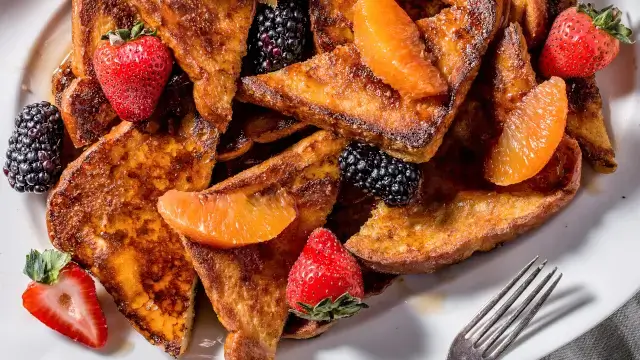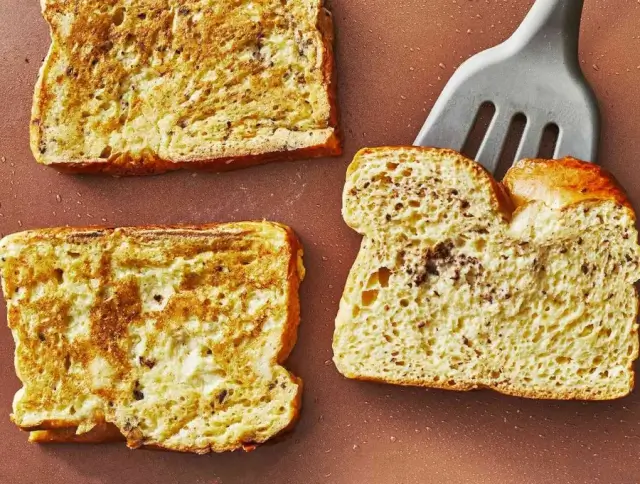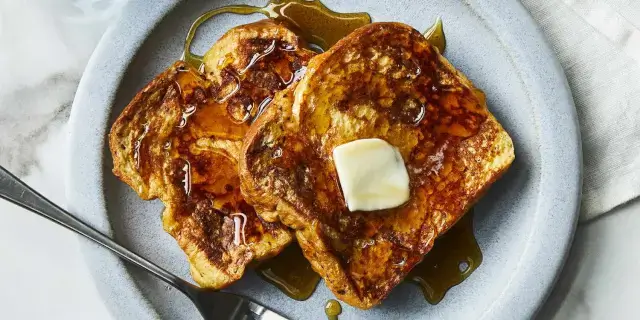French Toast Recipe Review
What makes a French toast so exceptional? We'll divulge the magic ingredient that turns regular bread into a remarkable treat.
Table of Contents
Sweet Indulgence: The Perfect French Toast Made Easy
Greetings from the land of French toast, where delectability and simplicity collide! You don't need to look any farther if you're craving a delicious breakfast delight. Come along with us as we go on a gastronomic adventure to uncover the mysteries of the ideal French toast.
What makes a French toast so exceptional? We'll divulge the magic ingredient that turns regular bread into a remarkable treat.
How do you choose the ideal loaf of bread? Explore the world of sourdough, challah, and brioche to select the one that best meets your texture and flavor preferences.
How can you avoid having soggy French toast? Learn the shortcuts and techniques that will maintain the fluffy inside and crispy outside of your toast.

So, what is the secret to making the ideal French toast? As we walk you through each step, from stirring the batter to cooking it to golden perfection, get ready to witness a culinary masterpiece.
Savor a straightforward French toast recipe perfect for challah or brioche bread. Mix the milk, eggs, cinnamon, vanilla, and oil; wet the bread and cook until it turns golden. Serves 4 and is ideal for a wonderful breakfast with berries, syrup, and whipped cream.
A favorite morning staple, french toast has a lengthy and fascinating history that goes back thousands of years.
Though it is sometimes linked to France, its roots are not entirely French and date back much further. The delicacy, called "PAIN PERDU" (lost bread) in France, was a creative technique to repurpose stale bread; it was soaked in a mixture of milk and eggs and then perfectly fried.
This clever dish demonstrated the inventiveness of cooks from ages ago by ensuring that nothing went to waste.
The delight it brings to the breakfast table and its simplicity are what make French toast beautiful. It has changed over time, with every culture contributing its own unique touch to the fundamental formula.
French toast has evolved into a canvas for culinary inventiveness, from the inclusion of sweet spices like nutmeg and cinnamon to the ostentatious toppings of fresh fruit, syrup, and whipped cream. The essence of French toast, despite its geographical variances, is always the same: transforming basic ingredients into a beautiful meal that pleases the heart and fulfills the soul.
Best French Toast Recipe
I made French toast in a variety of ways, but I eventually discovered that simplicity is ideal. My favorite recipe is this one because it's delicious and simple to make. It's ideal for leisurely Saturday mornings. Let this be your unique recipe, demonstrating that sometimes the simplest solution is the best.
What ingredients are in French Toast?
Bread
Milk
Eggs
Vanilla
Sugar
Cinnamon
What is The Best Bread for French Toast?
Making French toast with the correct bread can make all the difference in the world. This is a short guide that will help you find your ideal partner while keeping things straightforward and sweet (or savory, if that's more your style!).

First things first, you need bread that can withstand the egg mixture without becoming a soggy mess. This bread should be sturdy and eggy. Thick-cut Texas toast, challah, and brioche are great for this since they have a hint of egg and butter flavor and are sturdy enough to hold up to all that sweetness without crumbling.
Slightly Stale: Now, freshly baked bread may be overly soft from the start. But don't worry! In fact, day-old bread works better for French toast because it perfectly absorbs the egg mixture, giving you the ideal combination of crispy exterior and soft within. To prepare bread for dipping, quickly roast it in the oven to slightly dry it out if it's still new.
Flavorful: Consider your preferences when it comes to taste. Rich and extremely buttery, brioche tastes fantastic with sweet toppings. The flavor of challah is pleasant and somewhat sweet. How about sourdough? It adds a hint of tartness that could go well with salty garnishes.
Here’s a quick rundown of some popular choices:
Brioche : It’s like the superstar of this recipe. Rich, buttery , and just decadent.
Challah : Eggy and a bit sweet, making it another top pick.
Thick-cut Texas toast : Easy to find and has a great structure for soaking up all that egg mixture .
Sourdough : A bit sturdy and tangy, offering a nice twist for those who like a little zing.
The best part is experimenting with many kinds to find your favorite. There is a bread out there that will make your French toast just the way you like it, whether it's the dreamy, creamy brioche or the distinct kick of sourdough. So feel free to try new things!
How to Make a French Toast
Begin by grabbing a small bowl and whisking together your eggs, milk, cinnamon, vanilla extract, and salt. This mixture will give your bread the delicious, custardy center that makes French toast so popular.
Take your bread now; stale bread absorbs the egg mixture the finest without becoming overly mushy. For roughly three seconds on each side, dip each slice into the egg mixture. Make sure it's well coated, but don't let it sit for too long.
The ideal texture is one in which the middle remains soft and custardy but not wet, and the outside crisps up nicely.

In a pan, melt a small amount of butter over medium heat. Add your moistened bread slices when it has melted. Allow them to cook for three to four minutes on each side, or until they turn a gorgeous golden brown. Place them on a wire rack if you plan to eat them right away so they stay crispy.
It's important to keep the first batches of French toast warm when making it for a large crowd. Stacking the cooked slices on a baking sheet and baking them at 250 degrees is a simple trick. This keeps them warm without causing them to get wet.
Although it's a fast cure, microwaving your French toast could cause it to become mushy. Toasting them briefly in the toaster is a better way to enjoy them later.
This restores their delicious crunch, giving them the taste of freshly produced food even after they have been refrigerated for some time.
By following this one step, you can make sure your French toast stays crispy and warm, ready to be devoured whenever you're ready. It's ideal for casual weekend brunches or when you need to feed a large group of people and want every slice to be perfectly cooked.
Toppings For French Toast
Butter
Maple Syrup
Fruit
Whipped Cream – Whip Some Heavy Cream With Some Sugar For Fresh Whipped Cream.
Powdered Sugar
Raspberries
Blueberries
Strawberries
Blackberries
Peaches
Sliced Almonds
Soggy French Toast
A great morning is thwarted by soggy French toast! It happens when the bread absorbs too much of the egg mixture, giving the inside a disappointingly mushy texture rather than a light and fluffy interior.
But worry not—there are strategies to stop it and get that ideal ratio of crispy outside to fluffy within. What you can do is as follows:
Choosing the Right Bread:
Stale bread is preferable to fresh since the latter absorbs too much custard and becomes soggy. Choose day-old bread such as thick-cut Texas toast, challah, or brioche. These stand up better because of their stronger structure.
A quick dry: Lightly drying out new bread is a quick remedy if that's all you have. Toast it for a couple of minutes on the lowest setting in your toaster or bake the slices for a few minutes at 300°F (150°C) on a baking sheet in a preheated oven. Make careful it doesn't brown, though.
Cooking is Key:
You should not turn up the heat; instead, use medium heat! To slowly cook your French toast, use a medium-low heat setting. This prevents the outside from burning and scorching the interior, which could result in sogginess and retained moisture.
Avoid packing the pan: Cooking an excessive number of slices at once may cause the pan's temperature to drop and cause uneven cooking, which could result in soggy French toast.
Bonus Tip:
Melted butter: Use melted butter instead of oil to cook your French toast. Butter adds a richer flavor and helps achieve a nice golden brown color.
What type of bread is best for French toast?
The “best” bread depends on your preference, but some general tips:
Sturdy and eggy: Because they include more eggs and butter and maintain their shape better, brioche, challah, or thick-cut Texas toast are excellent options.
A little bit stale: Bread that is a day older absorbs the custard evenly without becoming mushy. Toast the bread for a little while to dry it out if it's fresh.
Taste profile: Think about the toppings you use. Rich and buttery, brioche is perfect for sweet toppings. Sourdough adds a dash of acidity to savory selections, while challah provides a tinge of sweetness.
How do I keep French toast warm for a crowd?
Here’s a simple trick to keep your French toast warm without getting soggy:
Preheat your oven to 250°F (120°C).
After cooking, arrange the French toast slices on a baking sheet in a single layer.
Pop them in the oven to maintain warmth. This prevents sogginess from microwaving and revives crispness later.
What can I do to prevent soggy French toast?
Soggy French toast is a bummer! Here’s how to achieve a delightful balance:
Choose day-old bread; it will keep better. Examples of such breads are challah and brioche.
Avoid over-soaking: Give each slice a quick 10 to 15 second dip in the egg mixture. Even less soaking time might be needed for a thicker custard.
Cook on medium heat: To cook slowly, use medium-low heat. This permits uniform cooking without scorching the exterior, which could retain moisture and result in sogginess.
Avoid packing the pan: Cooking too many slices at once causes the temperature to drop and encourages uneven cooking, which could lead to sogginess.
What are some topping ideas for French toast?
French toast is a canvas for creativity! Here are some classic and exciting options:
Classic sweet: Maple syrup, powdered sugar, fresh berries, whipped cream.
Fruity delights: Sliced bananas, peaches, mangoes, with a drizzle of honey or agave nectar.
Nutty twist: Toasted almonds, pecans, walnuts, with a maple syrup and cinnamon combo.
Savory surprise: Top with sautéed vegetables, cheese, and a drizzle of hot sauce.
Can I make French toast ahead of time?
Absolutely! Here’s how to prep French toast in advance:
Prepare the French toast batter and soak the bread slices. Cover and refrigerate for up to 24 hours.
When ready to cook, remove the soaked bread and let it sit at room temperature for 15-20 minutes. Cook as usual.
What are some vegan or vegetarian variations of French toast?
Here are some delicious plant-based options:
To make vegan French toast, replace the eggs with flaxseed or chia seeds and include vegan milk (almond, soy, or oat) into the batter. Garnish with vegan whipped cream and fresh fruit.
Vegetarian French Toast: Use mashed avocado and plant-based milk in place of conventional eggs in the batter. Top with crumbled cheese to increase the protein content.
Frequently Asked Questions
What are the essential ingredients in French toast?
The essential ingredients for French toast are bread, milk, eggs, vanilla, sugar, and cinnamon.
How do I prevent soggy French toast?
To prevent soggy French toast, choose sturdy bread like brioche or challah, avoid over-soaking the bread in the egg mixture, cook over medium heat and don't crowd the pan.
What topping ideas can I use for French toast?
Classic toppings include maple syrup, powdered sugar, fresh berries, and whipped cream. Other creative options range from fruit such as bananas and peaches to nuts like almonds and pecans, or savory toppings like sautéed vegetables and cheese.
Conclusion
A classic morning food that has been enjoyed for generations, french toast has captured people's palates all across the world.
Remember that the secret to avoiding soggy French toast is to choose the correct bread, absorb the egg mixture uniformly, and cook it carefully. There are countless culinary exploration opportunities with French toast, regardless of your preference for traditional sweet toppings or daring savory ingredients.
Now go forth and explore your options for bread, feed your creativity with unique toppings, and allow the scent of freshly baked French toast fill your kitchen as it fills your breakfast table with warmth and happiness.
Notice: Internet users spontaneously contributed the article content, and the article views only represent the author himself. This site only provides storage services, does not have ownership, and bears relevant legal liabilities. If you find plagiarism, infringement, or illegal content, please contact the administrator to delete it.



